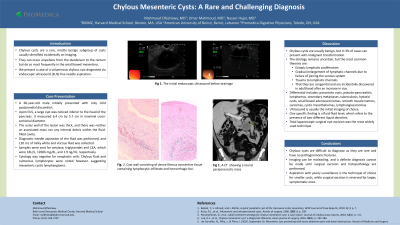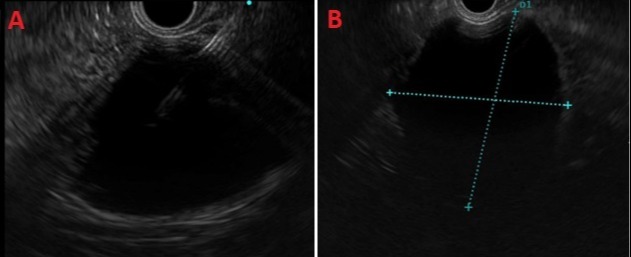Sunday Poster Session
Category: General Endoscopy
P0575 - Chylous Mesenteric Cyst: A Challenging Diagnosis
Sunday, October 22, 2023
3:30 PM - 7:00 PM PT
Location: Exhibit Hall

Has Audio

Mahmoud F. Elfeshawy, MBChB
Beth Israel Deaconess Medical Center
Boston, MA
Presenting Author(s)
Mahmoud F. Elfeshawy, MBChB1, Nasser Hajar, MD2
1Beth Israel Deaconess Medical Center, Boston, MA; 2Promedica Physicians Digestive Health Care, Toledo, OH
Introduction: Chylous cysts are rare disorders of probable lymphatic origin that develop in the mesentery of the gastrointestinal tract. They can occur anywhere from the duodenum to the rectum but do so most frequently in the small bowel mesentery. First described by Rokitansky in 1842, they commonly occur in the fifth decade of life and are identified in about 1 in 100,000 patients. Chylous cysts have no pathognomonic symptoms, and treatment is usually surgical. This article presents a case of a voluminous cyst diagnosed via endoscopic ultrasound fine needle aspiration.
Case Description/Methods: A 66-year-old male initially presented with a large, peripancreatic cyst located inferior to the head of the pancreas. He reported mild postprandial discomfort but denied heartburn, dysphagia, and weight loss. He also denied any history of pancreatitis or alcohol consumption and reported quitting smoking in 1996. His paternal grandfather had gastric cancer; otherwise family history was noncontributory.
Upon EUS in April 2022, an anechoic lesion suggestive of a cyst was identified in the peripancreatic region. It did not communicate with the pancreatic duct. The outer wall of the lesion was thick, and there was neither an associated mass, nor any internal debris within the fluid-filled cavity. Diagnostic needle aspiration of the fluid was performed, and 120 mL of milky white and viscous fluid was collected. Samples were sent for amylase and triglyceride concentration, and CEA, which were reported to be 18U/L, 12606 mg/dL, and 1.9 ng/ml, respectively. Cytology was negative for neoplastic cells. However, chylous fluid and numerous lymphocytes were noted, suggesting mesenteric cystic lymphangioma.
Discussion: Chylous cysts are usually benign, but in 3% of cases, they can malignantly transformation. The etiology of these cysts remains uncertain, however. A popular theory is that the lymphatic fluid originates from the thoracic duct. Another proposed that it could be due to ectopic lymphatic proliferation. Others suggest that the lesions are congenital and are only discovered in adulthood after increasing in size.
They can also present as pancreatic pseudocysts, tumors, ovarian cysts, or abdominal aortic aneurysms. Although abdominal pain is the most common symptom, symptoms can vary and are numerous and vague, such as discomfort and nausea, to compression of adjacent structures, intestinal obstruction, hemorrhage or acute abdomen; or be absent entirely as was the case here.

Disclosures:
Mahmoud F. Elfeshawy, MBChB1, Nasser Hajar, MD2. P0575 - Chylous Mesenteric Cyst: A Challenging Diagnosis, ACG 2023 Annual Scientific Meeting Abstracts. Vancouver, BC, Canada: American College of Gastroenterology.
1Beth Israel Deaconess Medical Center, Boston, MA; 2Promedica Physicians Digestive Health Care, Toledo, OH
Introduction: Chylous cysts are rare disorders of probable lymphatic origin that develop in the mesentery of the gastrointestinal tract. They can occur anywhere from the duodenum to the rectum but do so most frequently in the small bowel mesentery. First described by Rokitansky in 1842, they commonly occur in the fifth decade of life and are identified in about 1 in 100,000 patients. Chylous cysts have no pathognomonic symptoms, and treatment is usually surgical. This article presents a case of a voluminous cyst diagnosed via endoscopic ultrasound fine needle aspiration.
Case Description/Methods: A 66-year-old male initially presented with a large, peripancreatic cyst located inferior to the head of the pancreas. He reported mild postprandial discomfort but denied heartburn, dysphagia, and weight loss. He also denied any history of pancreatitis or alcohol consumption and reported quitting smoking in 1996. His paternal grandfather had gastric cancer; otherwise family history was noncontributory.
Upon EUS in April 2022, an anechoic lesion suggestive of a cyst was identified in the peripancreatic region. It did not communicate with the pancreatic duct. The outer wall of the lesion was thick, and there was neither an associated mass, nor any internal debris within the fluid-filled cavity. Diagnostic needle aspiration of the fluid was performed, and 120 mL of milky white and viscous fluid was collected. Samples were sent for amylase and triglyceride concentration, and CEA, which were reported to be 18U/L, 12606 mg/dL, and 1.9 ng/ml, respectively. Cytology was negative for neoplastic cells. However, chylous fluid and numerous lymphocytes were noted, suggesting mesenteric cystic lymphangioma.
Discussion: Chylous cysts are usually benign, but in 3% of cases, they can malignantly transformation. The etiology of these cysts remains uncertain, however. A popular theory is that the lymphatic fluid originates from the thoracic duct. Another proposed that it could be due to ectopic lymphatic proliferation. Others suggest that the lesions are congenital and are only discovered in adulthood after increasing in size.
They can also present as pancreatic pseudocysts, tumors, ovarian cysts, or abdominal aortic aneurysms. Although abdominal pain is the most common symptom, symptoms can vary and are numerous and vague, such as discomfort and nausea, to compression of adjacent structures, intestinal obstruction, hemorrhage or acute abdomen; or be absent entirely as was the case here.

Figure: Fig 1A: the initial US before endoscopic drainage
Fig 1B: the cyst measuring 6.4cm x 5.7 cm
Fig 1B: the cyst measuring 6.4cm x 5.7 cm
Disclosures:
Mahmoud Elfeshawy indicated no relevant financial relationships.
Nasser Hajar indicated no relevant financial relationships.
Mahmoud F. Elfeshawy, MBChB1, Nasser Hajar, MD2. P0575 - Chylous Mesenteric Cyst: A Challenging Diagnosis, ACG 2023 Annual Scientific Meeting Abstracts. Vancouver, BC, Canada: American College of Gastroenterology.
